Tapio Wirkkala
Tapio Veli Ilmari Wirkkala (2 June 1915 – 19 May 1985) was a Finnish designer and sculptor, a major figure of post-war design.
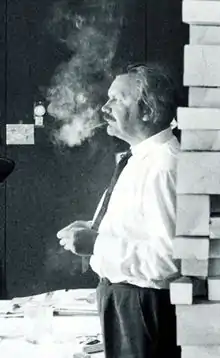
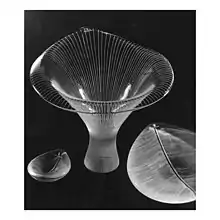

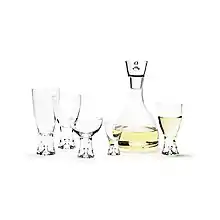
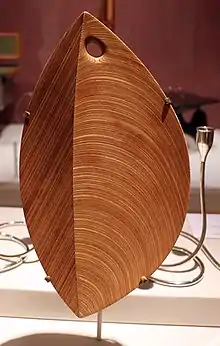
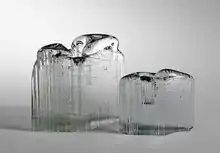

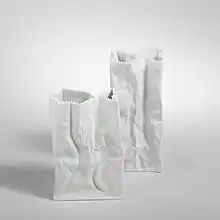
Life and work
Wirkkala was born in Hanko in 1915. He attended the Töölö co-educational school in Helsinki. His father, Ilmari Wirkkala, was a cemetery architect, and mother Selma (née Vanhatalo) a wood-carver. His sister Helena Korvenkontio and brother Tauno Wirkkala were also artists.[1]
Wirkkala's work ranges from designs of plastic ketchup bottles and metalware to glass, ceramics and plywood in a range of styles. His success as a glass designer began in 1946 when he designed the Kantarelli vase for Iittala, and the mass-produced Tapio collection was launched in 1954. His range was immense, including glassware, stoneware, jewelry, and furniture for mass production, as well as individual sculptures in several media. He also designed the Finnish markka banknotes introduced in 1955. In the early 1950s, Wirkkala worked as the artistic director at the Helsinki Central School of Industrial Design.[2]
Among his most famous work have been the designs for the Finlandia vodka bottle (1970-1999) and for Iittala's Ultima Thule set of kitchen glasses. Both glassware items feature a dripping icicle look, and in the case of the Iittala's glassware it is said to have taken thousands of hours to develop a glassblowing technique that would produce the effect.
Wirkkala did much of his initial design work using a traditional Finnish carving knife, the puukko. Wirkkala designed his own version of the knife, the Tapio Wirkkala Puukko, which was manufactured by Hackman Cutlery and marketed by Brookstone in the US in the early-1970s.
Wirkkala died in Helsinki on 19 May 1985 and was buried in the artists' area of the Hietaniemi Cemetery, next to his wife Rut Bryk.[3]
Awards and distinctions
- 1st and 2nd place, Bill Designing Competition of Bank of Finland 1947
- 4 awards, Designing Olympic Stamps 1951, for the 1952 Summer Olympics[4]
- 3 Grand Prix at the 9th Milan Triennuial, 1951[5]
- 3 Grand Prix, at the 10th Milan Triennuial, 1954[5]
- Lunning Prize 1951[6]
- Order of the Lion of Finland -medal 1955
- 1st place, the World Fair in Brussels 1957[7]
- Society of Industrial Arts Medal of the Year 1958
- Grand Prix and Gold Medal, Milan 1960; Silver Medal, Milan 1963
- Domus Golden Obelisk, Milan 1963[7]
- Gold Medal of the President of Italy, Faenza International Ceramics Competition 1963, 1966, 1967, 1969 and 1973[8]
- Premio Internazionale Vicenza 1963, 1966 and 1967[8]
- Honorary Royal Designer of Industry, London 1964[8]
- Honorary Prize, the Finnish Cultural Foundation 1968[8]
- Honorary doctorate, Royal College of Arts, London 1971[8]
- Honorary Member of the Worshipful Company of Goldsmiths, London 1971[8]
- Academy of Finland's honorary title of academician 1972[8]
- Teosto organization's medal for Creative Work 1980[8]
- Prince Eugen Medal, Stockholm 1980[8]
References
- "Wirkkala, Tapio (1915–1985)". National Biography of Finland. Retrieved 17 June 2019.
- "Tapio Wirkkala design". www.finnishdesignshop.com. Retrieved 2019-08-08.
- "Taiteilijainmäki V21A". Helsingin seurakuntayhtymä. 25 April 2015.
- Wagner, Juergen. "Postage stamps Olympic Games 1952 Helsinki". Archived from the original on 2013-02-04.
- "404 – Design Forum Finland". Archived from the original on 2010-03-22.
- http://danishdesignreview.com/the-lunning-prize
- "Tapio Wirkkala: Applying the Finnish approach to design". thisisFINLAND.
- "Avards".
External links
- Tapio Wirkkala – Rut Bryk Foundation.
- Tapio Wirkkala website.
- Wirkkala biography at Iittala.com.
- Glass items designed by Tapio Wirkkala at Finnish glass fan site designlasi.com.
Gallery
 Finska markka
Finska markka Puukko hand knife
Puukko hand knife Tunturi, glass sculpture
Tunturi, glass sculpture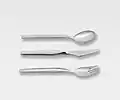 Caravelle cutlery
Caravelle cutlery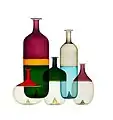 Bottles for Venini
Bottles for Venini